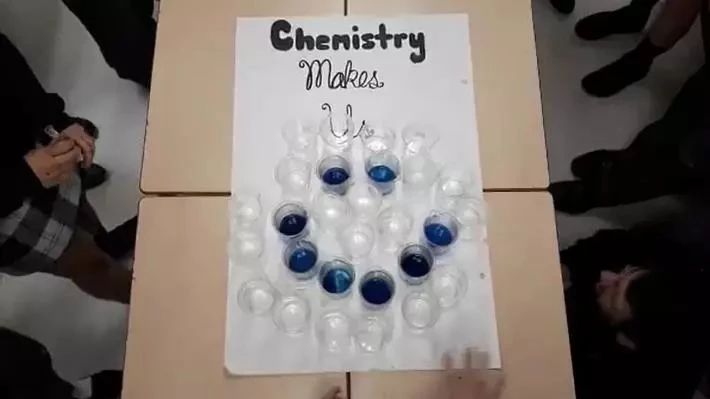
Chemistry makes us smile:)
recently I saw a creative experimental video posted by STMChem on Twitter:
people quickly put a lot of cups filled with transparent liquid together, and a few seconds later, the liquid in some cups turned dark blue, showing a smiling face. Chemistry makes us smile:)
the discolored smiling face actually uses the iodine clock reaction. When several colorless and transparent solutions are mixed together in this reaction, the color of the solution gradually turns yellow and then quickly turns dark blue. If you continue to observe, the blue will gradually fade, and the color changes in such a cycle until the reactants are exhausted.
(a complete discoloration cycle)
the color change of iodine clock reaction is naturally related to iodine. To put it simply, the colorless part corresponds to iodate radical or iodine ion, yellow corresponds to iodine element, and dark blue comes from the complex of iodine and starch. The change of color reflects the change of the content of these components in the reaction process.
there are several ways to realize the iodine clock phenomenon, and here is only one of the common ones. The three solutions mixed by this method contain: ① hydrogen peroxide; ② potassium iodate + sulfuric acid; ③ soluble starch + malonic acid + manganese sulfate.
Stunning spring formal dresses at surprisingly affordable price. Buy our selection of high quality at the most affordable price.
the reaction in this version can be generalized by the following reaction formula:
the reaction occurs between hydrogen peroxide, iodate and malonic acid, and the final result is that malonic acid is halogenated. Starch mainly plays an indicative role, and manganese ion is responsible for catalysis.
of course, just looking at this reaction formula can not see why the color changes periodically, the specific mechanism of the oscillatory reaction is very complicated. This thing called Briggs-Rauscher oscillatory reaction has a lot of research and model explanation. According to the model, it can be divided into 7, 8 to 30 reaction steps. If you are interested, you can find it. I'm not going to talk about _ (: oscillation "∠) _
. The specific experimental methods can be found here: https://projects.ncsu.edu/project/chemistrydemos/Kinetics/BriggsRauscher.pdf
Wikipedia.
(chemistry could have made me smile, but the smile disappeared after reading a paper on oscillatory reaction models. )